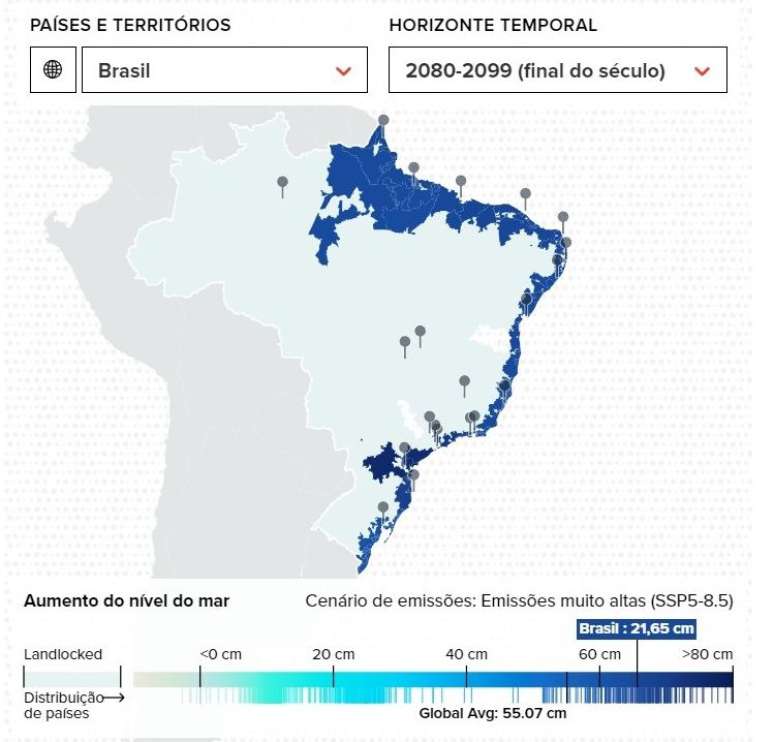United Nations estimates predict that by the end of the century, at least 5% of some cities could be permanently below sea level, including Rio and Santos
If greenhouse gas emissions continue to increase on the planet and cause the melting of glaciers, the United Nations (UN) predicts that sea levels will rise to the point that some cities will be partially submerged by 2100, including Rio de Janeiro (RJ) and Santos (SP). Australia is also expected to be heavily affected.
- The world’s largest iceberg is moving for the first time in 30 years
- The video shows the rapid rise in ocean levels in recent decades
The problem is estimated to peak at the end of the century, but, by 2050, permanent flooding may already be a problem in these locations, including Brazil. They will inevitably affect the lives of hundreds of thousands of people.
The forecasts were made through a UN partnership with the Climate Impact Lab (CIL) and are available for consultation on the Human Climate Horizons (HCH) platform.
Sea level rise
“Hundreds of highly populated cities will face an increasing risk of flooding by mid-century” due to sea level rise, says the UN in a note. If no measures are taken to curb climate change, the prediction is that areas occupied by 5% of the population in coastal cities will be at risk of facing the problem by 2050 – this includes Santos, for example.
Now, if nothing is done and the most drastic predictions are confirmed, the risk of cities being partially submerged will increase up to the areas where 10% of coastal populations live. In general, coastal regions are known to be highly occupied.
In this scenario, the prediction is that around 160,000 square kilometers of coastal territory will be inundated by 2100. This is an area larger than the territory of Greece or Bangladesh, for example.
Situation in Brazil

To understand the problem by looking at Brazil, sea levels are projected to rise by 27.74 cm in Santos and 23.84 cm in Rio, between the years 2040 and 2059, in the worst case scenario. Now, between 2080 and 2099, an increase of 72.85 cm and 65.67 cm is estimated respectively.
Cities will be partially submerged
According to the United Nations, without installing coastal defenses or measures to curb global warming, at least 5% of the following cities are expected to be permanently below sea level:
- Guayaquil, Ecuador;
- Barranquilla, Colombia;
- Santos, Brazil;
- Rio de Janeiro Brazil;
- Kingston, Jamaica;
- Cotonou, Benin;
- Calcutta, India;
- Perth, Australia;
- Newcastle, Australia;
- Sydney, Australia.
Is there time for change?
“These projections are not foregone conclusions,” says Hannah Hess, associate director of the Climate Impact Lab. However, they should not be seen as an irreversible inevitability, but rather as “a catalyst for action,” she suggests.
“Fast and sustainable actions to reduce emissions will influence the speed and magnitude of their impact on coastal communities. Reducing emissions not only mitigates risks, but also gives us more time to proactively respond and prepare for rising emissions. climate levels.”, adds Hess.
Source: UN AND Human climate horizons
Trends on Canaltech:
- Google explains the disappearance of files from Drive, but the problem continues
- Google will delete unused Gmail accounts this Friday (1st)
- Ferrari Purosangue arrives in Brazil for R$7.5 million; CT saw it up close
- 🤑 COUPON | Galaxy S23 Ultra at one of the lowest prices ever seen
- WhatsApp should show profile messages within conversations
- Wolverine shows off a bloody new use of his healing factor
Source: Terra
Rose James is a Gossipify movie and series reviewer known for her in-depth analysis and unique perspective on the latest releases. With a background in film studies, she provides engaging and informative reviews, and keeps readers up to date with industry trends and emerging talents.






